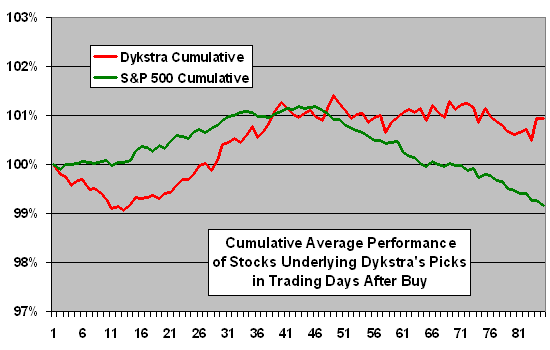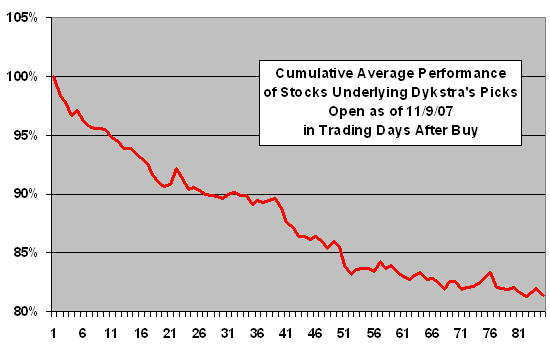Readers requested a review of the performance of recommendations made by Lenny Dykstra in his articles at TheStreet.com. The publication has engaged Lenny Dykstra for three stints: 9/6/05-8/14/06, 2/7/07-11/7/07 and 3/25/08-present. In these articles, he generally recommends buying deep-in-the-money call options four to six months from expiration for specific “undervalued” stocks, with a good-until-canceled sell order targeting a modest gain of about 10%. He attempts to find stocks on the rebound to mitigate the risk of holding options that eventually expire. He employs this “going deep” options strategy for some leverage with minimal option time value erosion. Can Lenny Dykstra systematically find undervalued stocks? Does his options strategy work? Using the “Stat Book Scorecard” from his 11/28/07 article (covering the recommendations from his second stint) and associated daily return data (close-to-close) for the underlying stocks and the S&P 500 index, along with the “Return on Investment” calculations from his 11/9/07 article, we conclude that:
As a first test, we construct and calculate the daily returns for a portfolio consisting of all the stocks underlying options positions recommended by Lenny Dykstra during 2/7/07-11/8/07 (121 separate recommendations encompassing 85 distinct stocks). We use daily closing prices adjusted for splits but not dividends to track prices that an options buyer experienced during subsequent holding periods. We keep each stock in the portfolio for four months to match the expiration-date approach of his options strategy. The portfolio ranges from one stock (at the very beginning and very end) to a high of 64 stocks. Average daily portfolio size is 38 stocks. Also in rough accordance with his options strategy, we calculate portfolio returns on an equally-weighted basis. Results are:
- The average daily return of the equally-weighted stock portfolio is 0.00% with standard deviation 1.02%.
- The average daily return for the value-weighted S&P 500 index over the same period is 0.00% with standard deviation 1.01%.
The average daily return for the stocks Lenny Dykstra picks matches that of the broad stock market almost exactly, suggesting no stock picking ability.
As a second test, we investigate how the performance of the underlying stocks suits the options strategy based on time variation. Rapid price appreciation would maximize return on investment with quick, successful trades and mitigate erosion of the relatively small time value of deep-in-the-money call options. For this test, we align the buy dates for all sample positions and construct an equally-weighted profile of the returns over a four-month period (about 84 trading days). For comparison, we construct a similar profile for the S&P 500 index by “buying” a four-month position in the index each time Lenny Dykstra recommends a new stock and aligning the start dates of all these index positions. The following chart presents the profiles, with description as follows:
- On average, Lenny Dykstra’s positions tend first to dip over two weeks and then recover and appreciate over the next six weeks before stabilizing for the balance of the four-month holding period.
- Comparable activity in the S&P 500 index on average beats Lenny Dykstra’s recommended stocks initially but falls behind after about two months.
Results suggest that Lenny Dykstra may be able to identify small intermediate-term undervaluations, but he tends to enter positions too quickly. He thereby on average “wastes” option time value during the month after the buy date.
Note that his return profile does not include trading costs/frictions. This profile is probably sensitive to market conditions.

As a third test, we examine the the assumptions in the return on investment calculations offered on 11/9/07 by Lenny Dykstra. These calculations have some shortcomings, as follows:
- Some of the calculations are for closed positions only, essentially assuming that open positions will perform similarly to closed positions. However, the strategy tends to carry a bow wave of unsuccessful positions that grows with market downdrafts. Given the behavior of the broad stock market in the four months after 11/9/07, the untracked open positions as of that date have probably degraded overall return on investment substantially.
- The calculations inconsistently address the cash position that a trader would have to maintain to assure the ability to implement new recommendations, including those for averaging down after short-term setbacks. A complete trading strategy would specify a closed system, defining the necessary cash position and including the return on cash in the overall return on investment.
- More generally, the strategy is sensitive to broad market conditions (trend and volatility). It would likely “crash” during a substantial market decline persisting for several months, with the crash magnified by a policy of averaging down rather than exiting after setbacks. As noted, the positions open as of 11/9/07 could well have crashed the overall return for recommendations made during 2/7/07-11/8/07.
The following chart amplifies points 1 and 3, showing the average cumulative performance of the stocks underlying Lenny Dykstra’s options positions that were open as of 11/9/07. The almost monotonic decline of the stocks suggests that many of the initial call option positions, and any subsequent buys to average down, may well have ended as total losses. Failure to follow up by incorporating the results of these positions in the overall return on investment calculations is deceptive.

Note that most of the formal research on trading and hedging with options (see the Equity Options category) indicates that odds for investors/traders are stacked against long calls and puts and for short calls and (especially) puts.
In summary, Lenny Dykstra’s deep-in-the-money call options (leveraged) strategy depends more on pure volatility and favorable market conditions than on skill in timing the movements of the underlying stocks. A substantial, multi-month market decline could cause the strategy to crash, seriously impacting long-term return on investment.
See the Guru Grades for links to evaluations of the commentaries and advice of other investing experts.